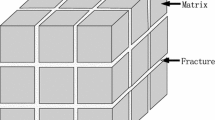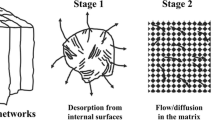Abstract
In the process of coalbed methane (CBM) mining, with the decreasing of reservoir pressure, stress sensitivity and matrix desorption shrinkage, which could be called self-regulating effect comprehensively, possess great effect on the gas adsorption due to the changing of pore volume. Therefore, it is necessary to modify the simplified local density (SLD) model to investigate the gas adsorption under reservoir conditions for an accurate prediction of CBM production. For the utilization of SLD adsorption model, assume the pores as slit pore. When pressure is lower than critical desorption pressure and keeps falling, the deformations of specific surface area (SSA) and pore width could be studied by the chosen Shi and Durucan (S&D) model. Furthermore, based on the variation relationship and the modification of SLD model, a new adsorption predicting model could be derived with the consideration of stress sensitivity, and matrix desorption shrinkage. In the absence of stress sensitivity and matrix desorption shrinkage, the calculated consequence is relatively smaller than the actual field adsorption data. What’s more, the sensitivity analyses of Poisson’s ratio, pore volume compressibility and critical desorption pressure are conducted with the application of this new model. At the same reservoir pressure, Poisson’s ratio possesses negative relationship with modified adsorption, while pore volume compressibility and critical desorption pressure both possess positive influence on modified adsorption. The main reason is that Poisson’s ratio affects matrix desorption shrinkage negatively, while pore volume compressibility and critical desorption pressure affect matrix desorption shrinkage positively. In spite of the opposite effect of stress sensitivity and matrix desorption shrinkage on pore deformation, matrix desorption shrinkage exhibits a dominant role in self-regulating.






Similar content being viewed by others
References
Bangham DH (1937) The Gibbs adsorption equation and adsorption on solids. Trans Faraday Soc 33:805–811
Busch A, Gensterblum Y, Krooss BM, Siemons N (2006) Investigation of high-pressure selective adsorption/desorption behaviour of CO2 and CH4 on coals: an experimental study. Int J Coal Geol 66:53–68. https://doi.org/10.1016/j.coal.2005.07.003
Chen JH, Wong DSH, Tan CS, Subramanian R, Lira CT, Orth M (1997) Adsorption and desorption of carbon dioxide onto and from activated carbon at high pressures. Ind Eng Chem Res 36:2808–2815. https://doi.org/10.1021/ie960227w
Chen D, Pan Z, Liu J, Connell LD (2013) An improved relative permeability model for coal reservoirs. Int J Coal Geol 109:45–57. https://doi.org/10.1016/j.coal.2013.02.002
Dahaghi AK (2010) Numerical simulation and modeling of enhanced gas recovery and CO2 sequestration in shale gas reservoirs: a feasibility study. In: SPE international conference on CO2 capture, storage, and utilization. Society of Petroleum Engineers. https://doi.org/10.2118/139701-MS
Fitzgerald J, Sudibandriyo M, Pan Z, Robinson R Jr, Gasem K (2003) Modeling the adsorption of pure gases on coals with the SLD model. Carbon 41:2203–2216. https://doi.org/10.1016/S0008-6223(03)00202-1
Foo KY, Hameed BH (2010) Insights into the modeling of adsorption isotherm systems. Chem Eng J 156:2–10
Golden TC, Sircar S (1994) Gas adsorption on silicalite. J Colloid Interface Sci 162:182–188
Harpalani S, Schraufnagel RA (1990) Shrinkage of coal matrix with release of gas and its impact on permeability of coal. Fuel 69:551–556. https://doi.org/10.1016/0016-2361(90)90137-F
Huang L, Ning Z, Wang Q, Ye H, Chen Z, Sun Z, Sun F, Qin H (2018a) Enhanced gas recovery by CO 2 sequestration in marine shale: a molecular view based on realistic kerogen model. Arab J Geosci 11:404. https://doi.org/10.1007/s12517-018-3762-5
Huang S, Yao Y, Zhang S, Ji J, Ma R (2018b) Pressure transient analysis of multi-fractured horizontal wells in tight oil reservoirs with consideration of stress sensitivity. Arab J Geosci 11:285. https://doi.org/10.1007/s12517-018-3639-7
Jiang Z, Zhao L, Zhang D (2018) Study of adsorption behavior in shale reservoirs under high pressure. J Nat Gas Sci Eng 49:275–285. https://doi.org/10.1016/j.jngse.2017.11.009
Lee LL (1988) Molecular thermodynamics of nonideal fluids. Butterworths
Ma Q, Harpalani S, Liu S (2011) A simplified permeability model for coalbed methane reservoirs based on matchstick strain and constant volume theory. Int J Coal Geol 85:43–48
Mao X, Liu Y, Guan W, Liu S, Li J (2018a) A new effective stress constitutive equation for cemented porous media based on experiment and derivation. Arab J Geosci 11:337. https://doi.org/10.1007/s12517-018-3697-x
Mao X, Liu Y, Guan W, Yueli F (2018b) Experimental and numerical simulation on the influence of anisotropic fracture network deformation to shale gas percolation. Arab J Geosci 11:615. https://doi.org/10.1007/s12517-018-3973-9
Mavor M, Vaughn J (1998) Increasing coal absolute permeability in the San Juan Basin fruitland formation. SPE Reserv Eval Eng 1:201–206. https://doi.org/10.2118/39105-PA
Palmer I, Mansoori J (1996) How permeability depends on stress and pore pressure in coalbeds: a new model. SPE Reserv Eval Eng 1:539–544. https://doi.org/10.2118/36737-MS
Peng Z, Li X (2018) Improvements of the permeability experiment in coalbed methane. Arab J Geosci 11:259. https://doi.org/10.1007/s12517-018-3608-1
Qi R, Ning Z, Wang Q, Zeng Y, Huang L, Zhang S, Du H (2018) Sorption of methane, carbon dioxide, and their mixtures on shales from Sichuan Basin, China. Energy Fuel 32:2926–2940
Sheng G, Javadpour F, Su Y (2018) Effect of microscale compressibility on apparent porosity and permeability in shale gas reservoirs. Int J Heat Mass Transf 120:56–65
Shi J, Durucan S (2004) Drawdown induced changes in permeability of coalbeds: a new interpretation of the reservoir response to primary recovery. Transp Porous Media 56:1–16. https://doi.org/10.1023/B:TIPM.0000018398.19928.5a
Shi J-Q, Durucan S (2005) A model for changes in coalbed permeability during primary and enhanced methane recovery. SPE Reserv Eval Eng 8:291–299. https://doi.org/10.2118/87230-PA
Zhao M, Yao z XM, Li J, Xu J (2013) Dynamic permeability model considering self-adjustment effect for coalbed methane. Fault-Block Oil Gas Field 1:63–66
Funding
This work was supported by the National Natural Science Foundation of China (Grants No. 51774298, No. 51974330, and No. 51574256)
Author information
Authors and Affiliations
Corresponding authors
Additional information
This article is part of the Topical Collection on Geo-Resources-Earth-Environmental Sciences
Appendix
Appendix
Due to the positive relationship of relative matrix deformation and the surface energy variation, there is a relational equation
where ε is the relative strain deformation and Δγ is the surface energy variation, J/m2.
Based on Gibbs equation (Bangham 1937), the surface energy variation is given by
where Γ is the surface concentration of adsorbed gas, mol/m2, which could be expressed as
where V is the gas adsorption at pressure p, m3/t, which could be expressed by Langmuir adsorption equation.
Combine Eq. (12) to (16); then the strain deformation caused by desorption
Rights and permissions
About this article
Cite this article
Wu, X., Ning, Z., Han, G. et al. Modified SLD model for coalbed methane adsorption under reservoir conditions. Arab J Geosci 12, 562 (2019). https://doi.org/10.1007/s12517-019-4763-8
Received:
Accepted:
Published:
DOI: https://doi.org/10.1007/s12517-019-4763-8




